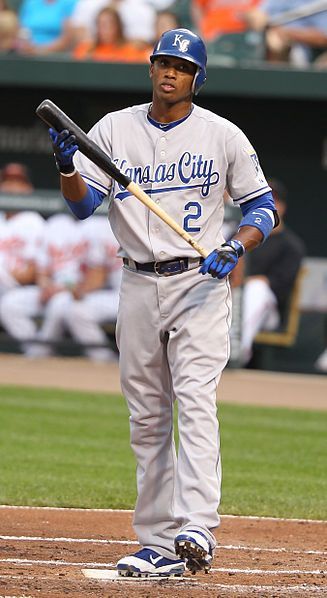
By Matthew Michaels
Lorde topped the charts of Billboard’s Hot 100 last October with her minimalistic “Royals.” The hit song denounces those who live a life of luxury. The New Zealand teenager was inspired to write the wildly popular single when she saw a picture in National Geographic of George Brett, arguably the best player in Kansas City Royals history, with the team name emblazoned on his jersey.
Of course, it is not too often the Royals are at number one like Lorde was. Kansas City last finished first in the standings in 1985, 11 years before the Grammy winner was born. That season, the Royals won the franchise’s only World Series and made their last playoff appearance until now. Their current 28-year playoff drought is not only the longest in the MLB, but among all four major North American sports leagues. After an 86-win 2013 campaign, the Royals are on the verge of consecutive winning seasons for the first time since the ’80s.
Just like “Royals,” the baseball team does not have the same kind of financial means as its competitors. In Lorde’s second verse, she sings: “My friends and I we’ve cracked the code. We count our dollars on the train to the party, [and everyone knows us knows that] we’re fine with this, we didn’t come from money.” Similarly, General Manager Dayton Moore has found a way to compete while spending significantly less than their main rivals, the Detroit Tigers. With an Opening Day payroll of $92 million, the Royals ranked 19th in spending for the second consecutive year. However, they have used shrewd moves and are well on their way to the party that is October baseball.
Oddly enough, the Royals are not a moneyball team like most small market, and even some large market, squads. They do not rely on getting on base and using raw power like moneyball teams do; entering play on Monday, the Royals’ 88 home runs and 319 walks were the lowest totals in the big leagues, while their .310 on-base percentage was second-lowest in the American League. They play a different type of ball.
The Royals put the ball in play often; their 831 strikeouts are the fewest by a margin of 127. They are far from a three-true outcome team. The team’s .261 batting average is a testament to its ability to make contact. Kansas City’s 130 stolen bases are the most in the majors while its base runners have been caught stealing only 27 times, proving it is not wild on the base paths and is talented in the art of selection.
The team’s speed also provides the foundation for a great defensive outfield. Alex Gordon’s 22.9 Ultimate Zone Rating is second among all outfielders and teammates Lorenzo Cain and Nori Aoki rank sixth and 16th respectively in UZR. If the innings minimum is reduced to 600, fourth outfielder and speedster Jarrod Dyson ranks fifth with 16.5 UZR. They stack up even taller based on Defensive Runs Saved. All told, the outfielders have combined to be the best defensively by far.
Former second overall draft pick Alex Gordon is finally hitting his stride after several disappointing seasons. His 5.7 Wins Above Replacement is seventh best in the majors. Catcher Salvador Perez remains a defensive stalwart behind the plate while being valuable offensively. The 24-year-old will finish his fourth big league season with a WAR north of four. Both Gordon and Perez made their second straight all-star team this season.
On the pitching side, James Shields has led the staff with another dominant season of over 200 innings pitched. With contributions from rookie flame-thrower Yordano Ventura, career journeyman Jason Vargas and a blossoming Danny Duffy, the Royals rotation has been a force to be reckoned with, even with Duffy’s recent injury. The seventh-eighth-ninth inning combination of Kelvin Herrera (1.37 ERA, 59.1 innings), Wade Davis (0.72 ERA, 62.1 innings) and closer Gregg Holland (1.60 ERA, 56.1 innings, 42 for 44 in save opportunities) has been one of the greatest ever this season. Holland especially has had a year for the ages; his 560 ERA+(100 being average) is unheard of, even though his two bullpen mates both have ERA+ of more than 250. Of the three, only Holland has allowed a home run in 2014, and he has only allowed three.
Amazingly, they are in contention despite all the things that have gone wrong for them. Infielders Eric Hosmer, Omar Infante and especially Mike Moustakas have had disappointing offensive production. Alex Gordon is the only regular who is having an above average offensive season. When the non-waiver trade deadline approached, many contenders felt obligated to make a splash, but not the Royals. Their big move was trading for backup catcher Erik Kratz and spot starter/long reliever Liam Hendricks from the Blue Jays. Meanwhile, the Tigers compelled themselves to add David Price, one of the game’s best pitchers, to an already impressive pitching staff. Compared to the team they are trying to beat out in the AL Central, Kansas City just sat on its hands, and the patience worked.
On May 28, the Royals were 24-28 and in last place in the division. They made up ground steadily but were still two games under .500 on July 21. They turned things around quickly; on Trade Deadline day, they were four games behind the Tigers. In September, they lead Detroit by a couple of games. Baseball Prospectus calculates their chance of making the postseason at 65 percent. It is likely their dreaded streak will finally come to a close this season.
This season, the Royals have no postcode envy. They lead the Tigers on a gold leash. That kind of luxe may not be for them, but they are Royals, and for once, they are playing like royalty.
__________
Matthew Michaels is a Staff Writer for The Fordham Ram.





































































































































































































